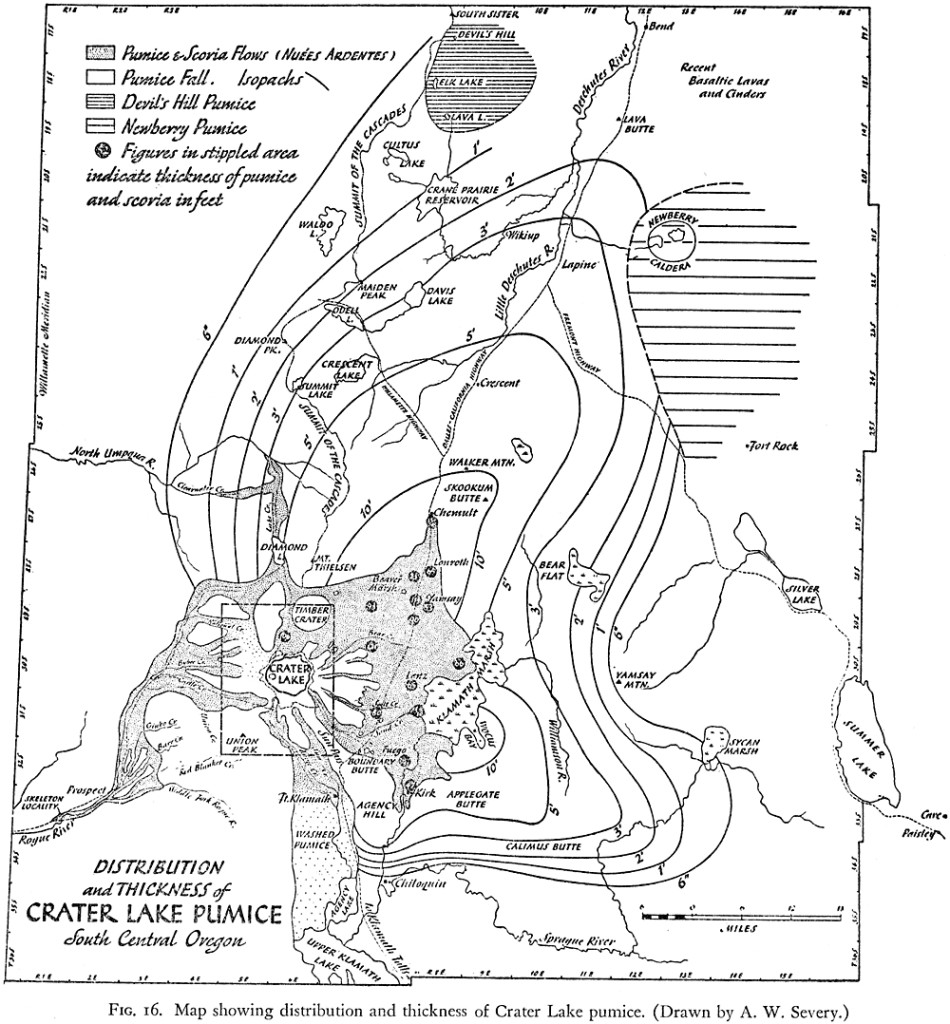Even 70 miles northeast of Crater Lake the pumice sheet is still a foot thick, and it therefore goes without saying that some of the finer ejecta must have spread for hundreds of miles. Probably the finest dust, like that from the eruptions of Krakatau in 1883, encircled the globe.
Perhaps no feature of the pumice fall is more striking than the scarcity of ejecta on the west and southwest slopes of Mount Mazama, even close to the rim of Crater Lake. For example, the veneer of pumice west of the Watchman and Hillman Peak is extremely and patchy; on Munson Ridge it is hardly more a light sprinkle, whereas on Vidae Ridge, a short to the east, the thickness locally exceeds 8 feet. Along the southwest rim of the caldera, the ice may be absent altogether. Red and Desert cones, on the northwest slopes of Mazama, though 2 and 4 miles, respectively, from the rim of the era, are so lightly veneered with pumice that it requires a careful search to find even a few fragments. Several explanations suggest themselves for the paucity of pumice so close to the source. The thinly covered slopes may have been blanketed with snow at the time of the eruptions; some of the slopes were later swept clean by the onrush of pumice flows; some may have been partly stripped by subsequent erosion. But the principal reason for the scarcity of pumice fall on the west and southwest sides of the volcano was simply that the winds were blowing in the opposite direction.
An observer would indeed have been safe in viewing the eruptions from the slopes of Union Peak, not more than 5 miles from the rim of Crater Lake. Occasional lumps of pumice up to 2 inches across fell on Union Peak, but by far the majority were less than 1/2 inch across, and even these were rare. The thick accumulation of pumice on Pumice Flat, near the east base of Union Peak, cannot be a product of these final explosions from Mount Mazama, for many of the lumps measure as much as 2 feet in diameter, and their pale-gray color contrasts distinctly with the pale-bluff tints of the final pumice fall. These coarser ejecta belong to an earlier explosive phase of the volcano, and are probably products of the eruptions which preceded the dacite flows from the Northern Arc of Vents. The same is true of the coarse pumice in the flats on the northwest side of Union Peak and in the depression northwest of Bald Crater.
Very little pumice fell west of Annie Creek, and scarcely a trace is to be found on the west side of the Klamath graben. On the opposite side, however, the pumice thickens with astonishing rapidity. Near Klamath Agency, for instance, the thickness increases from a few inches to more than 6 feet in a distance of only 3 miles.


